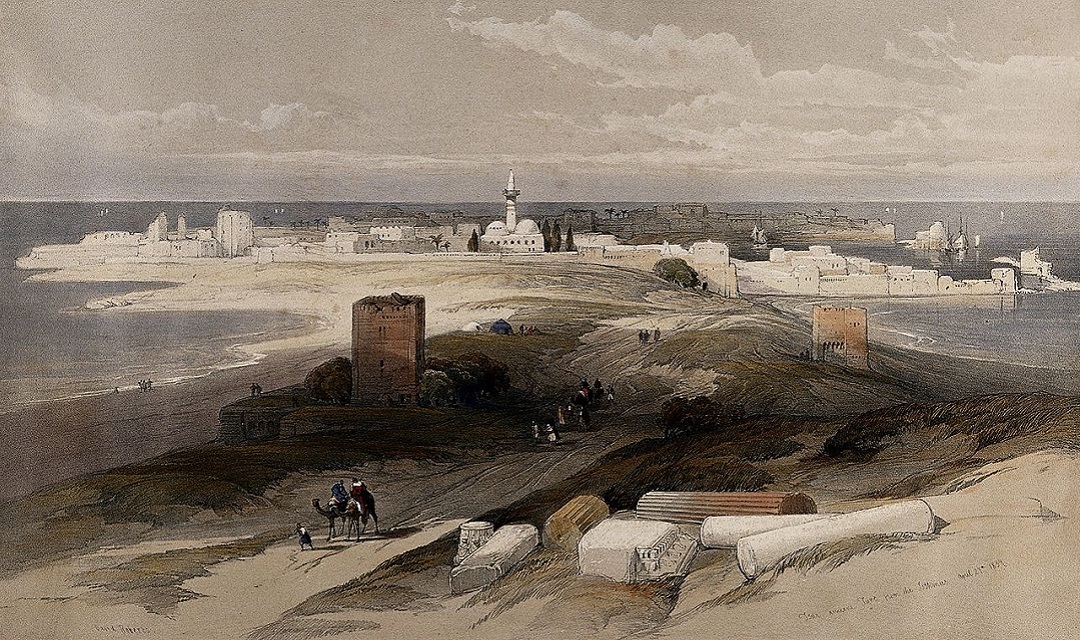This article first appeared in the Ask Hank column of the Christian Research Journal, volume 36, number 01 (2013). The full text of this article in PDF format can be obtained by clicking here. For more information about the Christian Research Journal, click here.
Following deportation to Babylon, Ezekiel prophesied that Tyre, which viewed the fall of Jerusalem in 586 BC as the pathway to further prosperity, would ultimately be destroyed. God would bring a succession of nations against Tyre as the ocean brings up its waves. The first of these nations would be Babylon, which would besiege the mainland, break down the walls of Tyre, and butcher its citizens. Moreover, according to the prophet, Tyre would be scraped bare as a rock and its rubble thrown into the midst of the sea (Ezek. 26:3ff).
What happened is a matter of history. A year after the destruction of Jerusalem, Nebuchadnezzar set his sights on destroying mighty Tyre—a gaudy and glittering oasis of luxury and wealth, queen of the seas as Babylon was king of the land. After a prolonged siege he succeeded in breaching the walls, destroying Tyre’s strong towers, and reducing the mainland to ruin and rubble. His efforts, however, went largely unrewarded. Recognizing the inevitability of the siege, the Tyrians transferred the bulk of their wealth to such colonies as Carthage or to their island citadel a kilometer off the mainland in the aqua blue waters of the Aegean Sea.
In time Babylon would fall to the allied forces of Media and Persia, but the island citadel of Tyre would continue its dance with prosperity. From the unassailable fortifications of their island fortress the Tyrians could still see the broken walls of a once-prosperous satellite city yet standing in mute testimony to broken and unfulfilled prophecy. Destroy Tyre? Throw the dust and debris of its mainland into the midst of the Aegean seas? Impossible—or so it seemed!
Time continued its inexorable march into the future and yet another empire would crumble into the dust bin of history. This time the Medo-Persian kingdom forged by Cyrus the Great would succumb to the iron fist of Alexander the Great. After soundly defeating Sidon, the Macedonian continued his relentless march toward Tyre. His emissaries enjoined the Tyrians to embrace peace. They responded in haughtiness and haste, throwing the dead bodies of Alexander’s ambassadors into the raging waters that surrounded their unbreachable citadel.
This time, however, the Tyrians had met their match. Alexander purposed to do the unthinkable. He commissioned Diades of Pella to engineer a resplendent causeway from the ruined city on the seashore to the regal citadel in the sea. Thus was fulfilled the most improbable of prophecies. In keeping with Ezekiel’s epic words, the mainland was scrapped bare as a rock and its stones, timber, and rubble thrown into the sea. With the causeway finally complete and battering rams in position, the island fortress was mercilessly crushed. Thirty thousand Tyrians were sold into slavery. Two thousand more were morbidly crucified. And still Alexander was not done. To ensure that Tyre would never regain its lofty status as the center of world commerce, Alexander purposed to make his namesake—Alexandria—the commercial capital of the world.
And still the prophecy was not complete. “I will bring many nations against you,” Ezekiel had prophesied, “like the sea casting up its waves” (Ezek. 26:31). Babylon, Greece, Egypt, and Rome would all have their way with the once peerless Phoenician capital. After the Arab conquest in AD 638, deterioration devolved toward destruction. In 1291 Muslim hordes swept what little remained into the ashbin of history. In 1838 Edward Robinson, widely regarded as “the father of biblical geography,” penned the following sobering thoughts:
I continued my walk along the whole western and northern shore of the peninsula, musing upon the pomp and glory, the pride and fall, of ancient Tyre. Here was the little isle, once covered by her palaces and surrounded by her fleets; where the builders perfected her beauty in the midst of the seas; where her merchants were princes, and her traffickers the honourable of the earth; but alas! “Thy riches and thy fairs, thy merchandise, thy mariners, and thy pilots, thy calkers, and the occupiers of thy merchandise, and all thy men of war, that were in thee and in all thy company,”—where are they? Tyre has indeed become like “the top of a rock, a place to spread nets upon!” The sole remaining tokens of her more ancient splendour, lie strewed beneath the waves in the midst of the sea; and the hovels which now nestle upon a portion of her site, present no contradiction of the dread decree, “Thou shalt be built no more!” [Isa. 23:8; Ezek. 26:4, 5, 12, 14; 27:4, 27]2
The king of Tyre said of Jerusalem, “Aha! The gate to the nations is broken, and its doors have swung open to me; now that she lies in ruins I will prosper” (Ezek. 26:2). The King of kings said of Tyre, “Because you think you are wise, as wise as a god, I am going to bring foreigners against you, the most ruthless of nations; they will draw their swords against your beauty and wisdom and pierce your shining splendor. They will bring you down to the pit, and you will die a violent death in the heart of the seas” (Ezek. 28:6–8).
Aerial photography provides a graphic pictorial of the precision with which Ezekiel’s prophecies have been fulfilled. Tyre’s once resplendent island citadel—replete with herculean temples, extravagant palaces, and opulent housing—is but a shipwreck; Tyre’s satellite city on the shore is abysmally bedecked by blacktop and block housing; and Diades’s ingenious causeway has become an impoverished peninsula pointing as a finger toward the once famous city now largely submerged in the heart of the seas.3
— Hank Hanegraaff
Hank Hanegraaff is president of the Christian Research Institute and host of the Bible Answer Man broadcast heard daily throughout the United States and Canada via radio, satellite radio Sirius-XM 131, and the Internet. For a list of stations airing the Bible Answer Man, or to listen online, log on to equip.org. Hank is the author of many books including the recently released AfterLife: What You Need to Know about Heaven, the Hereafter, and Near Death Experiences (Worthy Publishing, 2013).
NOTES
- Scripture quotations are from the NIV 1984.
- Edward Robinson and Eli Smith, Biblical Researches in Palestine and the Adjacent Regions: A Journal of Travels in the Year 1838, 2 (Boston: Crocker and Brewster, 1874), 463, online at http://books.google.com, last accessed January 9, 2013; the parenthetical Scripture references listed at the end of the quote are cited in the original as a footnote. For additional information on the history of Tyre, cf. Trudy Ring, Robert M. Salkin, Sharon La Boda, International Dictionary of Historic Places: Middle East and Africa (Chicago: Fitzroy Dearborn Publishers, 1996), 711ff.
- This article is adapted from Hank Hanegraaff, Has God Spoken? Memorable Proofs of the Bible’s Divine Inspiration (Nashville: Thomas Nelson, 2011), 122–24.









